Alexander Artikis
University of Piraeus
Dealing with Inconsistency for Reasoning over Knowledge Graphs: A Survey
Feb 26, 2025Abstract:In Knowledge Graphs (KGs), where the schema of the data is usually defined by particular ontologies, reasoning is a necessity to perform a range of tasks, such as retrieval of information, question answering, and the derivation of new knowledge. However, information to populate KGs is often extracted (semi-) automatically from natural language resources, or by integrating datasets that follow different semantic schemas, resulting in KG inconsistency. This, however, hinders the process of reasoning. In this survey, we focus on how to perform reasoning on inconsistent KGs, by analyzing the state of the art towards three complementary directions: a) the detection of the parts of the KG that cause the inconsistency, b) the fixing of an inconsistent KG to render it consistent, and c) the inconsistency-tolerant reasoning. We discuss existing work from a range of relevant fields focusing on how, and in which cases they are related to the above directions. We also highlight persisting challenges and future directions.
Complex Event Recognition with Symbolic Register Transducers: Extended Technical Report
Jul 03, 2024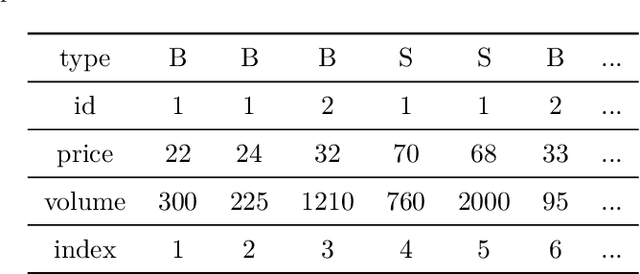
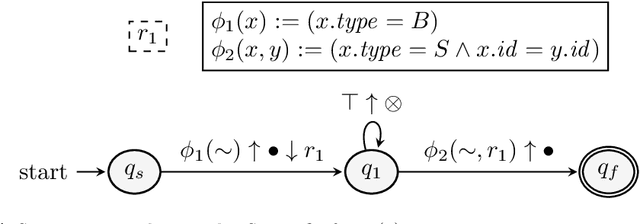


Abstract:We present a system for Complex Event Recognition (CER) based on automata. While multiple such systems have been described in the literature, they typically suffer from a lack of clear and denotational semantics, a limitation which often leads to confusion with respect to their expressive power. In order to address this issue, our system is based on an automaton model which is a combination of symbolic and register automata. We extend previous work on these types of automata, in order to construct a formalism with clear semantics and a corresponding automaton model whose properties can be formally investigated. We call such automata Symbolic Register Transducers (SRT). We show that SRT are closed under various operators, but are not in general closed under complement and they are not determinizable. However, they are closed under these operations when a window operator, quintessential in Complex Event Recognition, is used. We show how SRT can be used in CER in order to detect patterns upon streams of events, using our framework that provides declarative and compositional semantics, and that allows for a systematic treatment of such automata. For SRT to work in pattern detection, we allow them to mark events from the input stream as belonging to a complex event or not, hence the name "transducers". We also present an implementation of SRT which can perform CER. We compare our SRT-based CER engine against other state-of-the-art CER systems and show that it is both more expressive and more efficient.
Early Time-Series Classification Algorithms: An Empirical Comparison
Mar 03, 2022
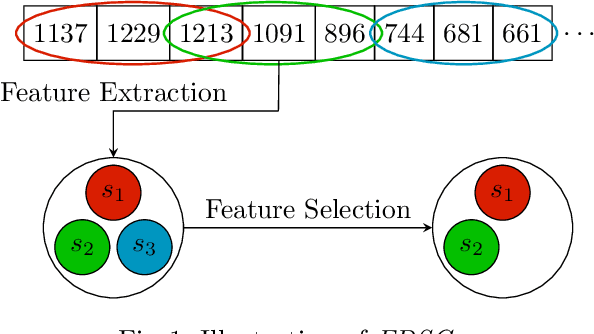


Abstract:Early Time-Series Classification (ETSC) is the task of predicting the class of incoming time-series by observing as few measurements as possible. Such methods can be employed to obtain classification forecasts in many time-critical applications. However, available techniques are not equally suitable for every problem, since differentiations in the data characteristics can impact algorithm performance in terms of earliness, accuracy, F1-score, and training time. We evaluate six existing ETSC algorithms on publicly available data, as well as on two newly introduced datasets originating from the life sciences and maritime domains. Our goal is to provide a framework for the evaluation and comparison of ETSC algorithms and to obtain intuition on how such approaches perform on real-life applications. The presented framework may also serve as a benchmark for new related techniques.
Symbolic Register Automata for Complex Event Recognition and Forecasting
Oct 08, 2021



Abstract:We propose an automaton model which is a combination of symbolic and register automata, i.e., we enrich symbolic automata with memory. We call such automata Symbolic Register Automata (SRA). SRA extend the expressive power of symbolic automata, by allowing Boolean formulas to be applied not only to the last element read from the input string, but to multiple elements, stored in their registers. SRA also extend register automata, by allowing arbitrary Boolean formulas, besides equality predicates. We study the closure properties of SRA under union, intersection, concatenation, Kleene closure, complement and determinization and show that SRA, contrary to symbolic automata, are not in general closed under complement and they are not determinizable. However, they are closed under these operations when a window operator, quintessential in Complex Event Recognition, is used. We show how SRA can be used in Complex Event Recognition in order to detect patterns upon streams of events, using our framework that provides declarative and compositional semantics, and that allows for a systematic treatment of such automata. We also show how the behavior of SRA, as they consume streams of events, can be given a probabilistic description with the help of prediction suffix trees. This allows us to go one step beyond Complex Event Recognition to Complex Event Forecasting, where, besides detecting complex patterns, we can also efficiently forecast their occurrence.
Complex Event Forecasting with Prediction Suffix Trees: Extended Technical Report
Sep 01, 2021



Abstract:Complex Event Recognition (CER) systems have become popular in the past two decades due to their ability to "instantly" detect patterns on real-time streams of events. However, there is a lack of methods for forecasting when a pattern might occur before such an occurrence is actually detected by a CER engine. We present a formal framework that attempts to address the issue of Complex Event Forecasting (CEF). Our framework combines two formalisms: a) symbolic automata which are used to encode complex event patterns; and b) prediction suffix trees which can provide a succinct probabilistic description of an automaton's behavior. We compare our proposed approach against state-of-the-art methods and show its advantage in terms of accuracy and efficiency. In particular, prediction suffix trees, being variable-order Markov models, have the ability to capture long-term dependencies in a stream by remembering only those past sequences that are informative enough. Our experimental results demonstrate the benefits, in terms of accuracy, of being able to capture such long-term dependencies. This is achieved by increasing the order of our model beyond what is possible with full-order Markov models that need to perform an exhaustive enumeration of all possible past sequences of a given order. We also discuss extensively how CEF solutions should be best evaluated on the quality of their forecasts.
Online Learning Probabilistic Event Calculus Theories in Answer Set Programming
Mar 31, 2021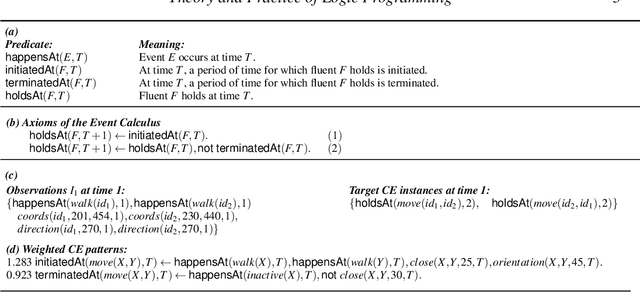
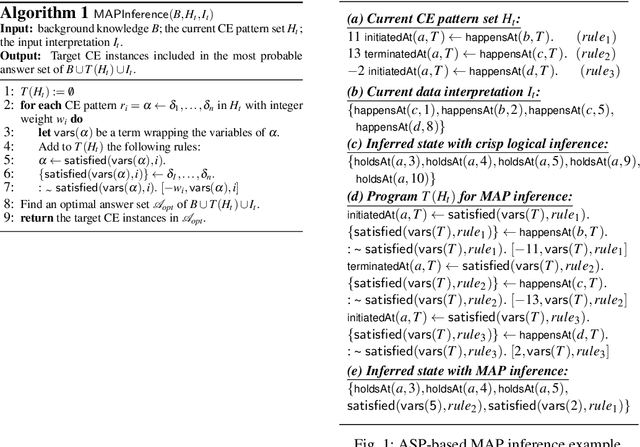
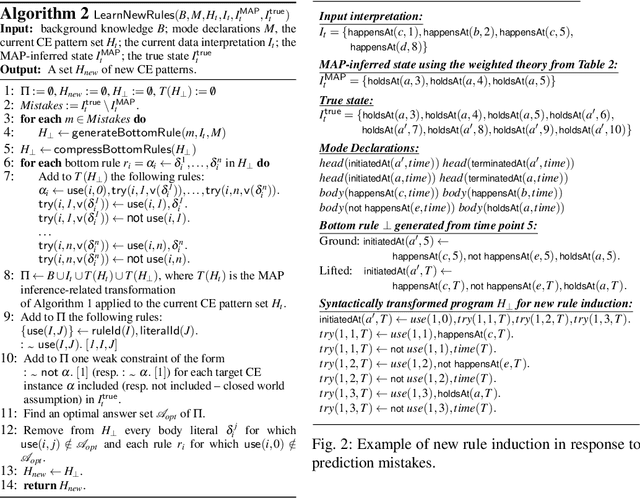
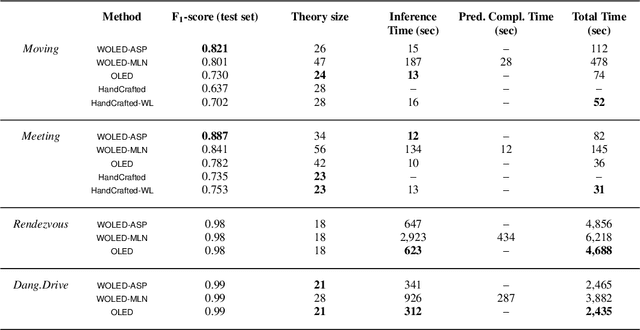
Abstract:Complex Event Recognition (CER) systems detect event occurrences in streaming time-stamped input using predefined event patterns. Logic-based approaches are of special interest in CER, since, via Statistical Relational AI, they combine uncertainty-resilient reasoning with time and change, with machine learning, thus alleviating the cost of manual event pattern authoring. We present a system based on Answer Set Programming (ASP), capable of probabilistic reasoning with complex event patterns in the form of weighted rules in the Event Calculus, whose structure and weights are learnt online. We compare our ASP-based implementation with a Markov Logic-based one and with a number of state-of-the-art batch learning algorithms on CER datasets for activity recognition, maritime surveillance and fleet management. Our results demonstrate the superiority of our novel approach, both in terms of efficiency and predictive performance. This paper is under consideration for publication in Theory and Practice of Logic Programming (TPLP).
Proceedings 36th International Conference on Logic Programming (Technical Communications)
Sep 19, 2020Abstract:Since the first conference held in Marseille in 1982, ICLP has been the premier international event for presenting research in logic programming. Contributions are solicited in all areas of logic programming and related areas, including but not restricted to: - Foundations: Semantics, Formalisms, Answer-Set Programming, Non-monotonic Reasoning, Knowledge Representation. - Declarative Programming: Inference engines, Analysis, Type and mode inference, Partial evaluation, Abstract interpretation, Transformation, Validation, Verification, Debugging, Profiling, Testing, Logic-based domain-specific languages, constraint handling rules. - Related Paradigms and Synergies: Inductive and Co-inductive Logic Programming, Constraint Logic Programming, Interaction with SAT, SMT and CSP solvers, Logic programming techniques for type inference and theorem proving, Argumentation, Probabilistic Logic Programming, Relations to object-oriented and Functional programming, Description logics, Neural-Symbolic Machine Learning, Hybrid Deep Learning and Symbolic Reasoning. - Implementation: Concurrency and distribution, Objects, Coordination, Mobility, Virtual machines, Compilation, Higher Order, Type systems, Modules, Constraint handling rules, Meta-programming, Foreign interfaces, User interfaces. - Applications: Databases, Big Data, Data Integration and Federation, Software Engineering, Natural Language Processing, Web and Semantic Web, Agents, Artificial Intelligence, Bioinformatics, Education, Computational life sciences, Education, Cybersecurity, and Robotics.
Optimizing Vessel Trajectory Compression
May 11, 2020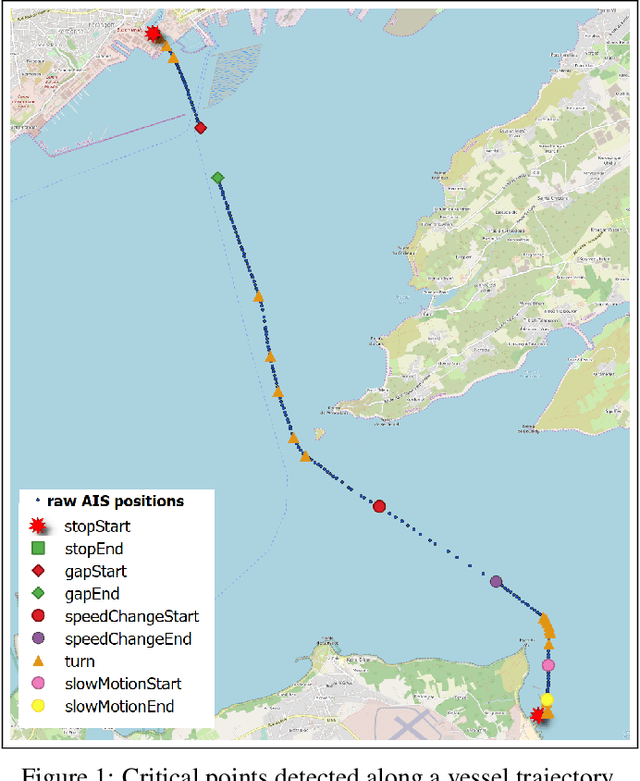
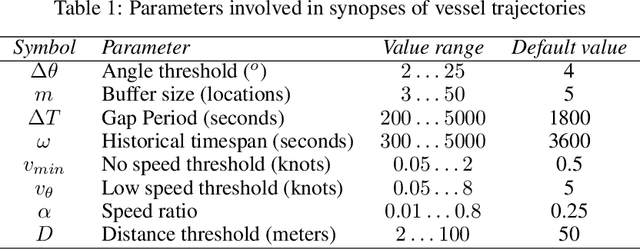
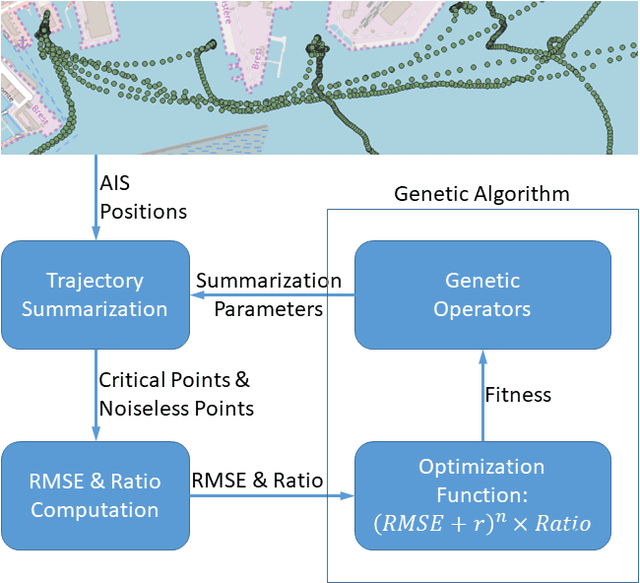

Abstract:In previous work we introduced a trajectory detection module that can provide summarized representations of vessel trajectories by consuming AIS positional messages online. This methodology can provide reliable trajectory synopses with little deviations from the original course by discarding at least 70% of the raw data as redundant. However, such trajectory compression is very sensitive to parametrization. In this paper, our goal is to fine-tune the selection of these parameter values. We take into account the type of each vessel in order to provide a suitable configuration that can yield improved trajectory synopses, both in terms of approximation error and compression ratio. Furthermore, we employ a genetic algorithm converging to a suitable configuration per vessel type. Our tests against a publicly available AIS dataset have shown that compression efficiency is comparable or even better than the one with default parametrization without resorting to a laborious data inspection.
Online Event Recognition from Moving Vehicles: Application Paper
Jul 25, 2019



Abstract:We present a system for online composite event recognition over streaming positions of commercial vehicles. Our system employs a data enrichment module, augmenting the mobility data with external information, such as weather data and proximity to points of interest. In addition, the composite event recognition module, based on a highly optimised logic programming implementation of the Event Calculus, consumes the enriched data and identifies activities that are beneficial in fleet management applications. We evaluate our system on large, real-world data from commercial vehicles, and illustrate its efficiency. Under consideration for acceptance in TPLP.
Composite Event Recognition for Maritime Monitoring
Mar 08, 2019
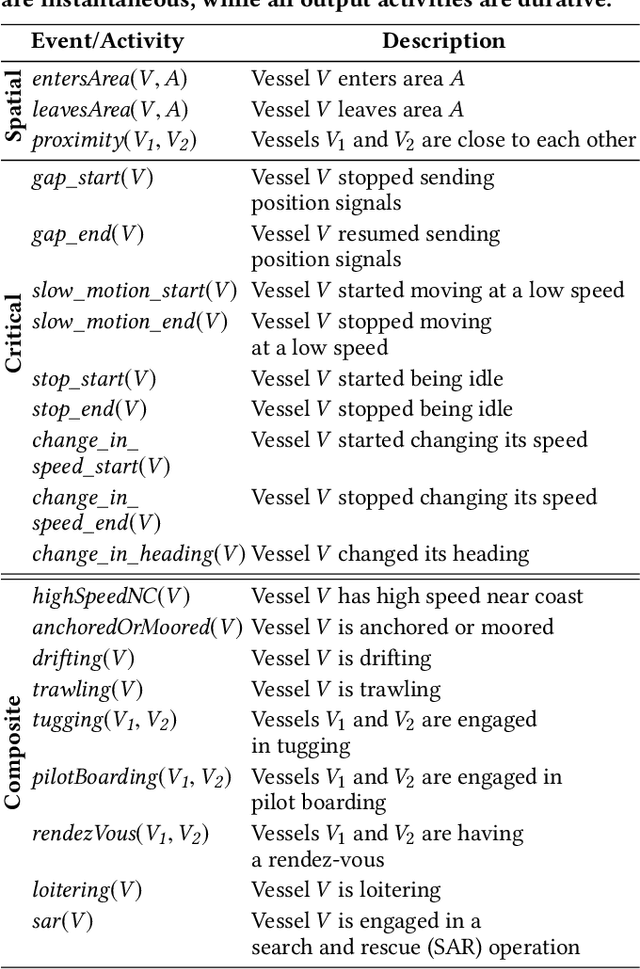


Abstract:Maritime monitoring systems support safe shipping as they allow for the real-time detection of dangerous, suspicious and illegal vessel activities. We present such a system using the Run-Time Event Calculus, a composite event recognition system with formal, declarative semantics. For effective recognition, we developed a library of maritime patterns in close collaboration with domain experts. We present a thorough evaluation of the system and the patterns both in terms of predictive accuracy and computational efficiency, using real-world datasets of vessel position streams and contextual geographical information.
 Add to Chrome
Add to Chrome Add to Firefox
Add to Firefox Add to Edge
Add to Edge